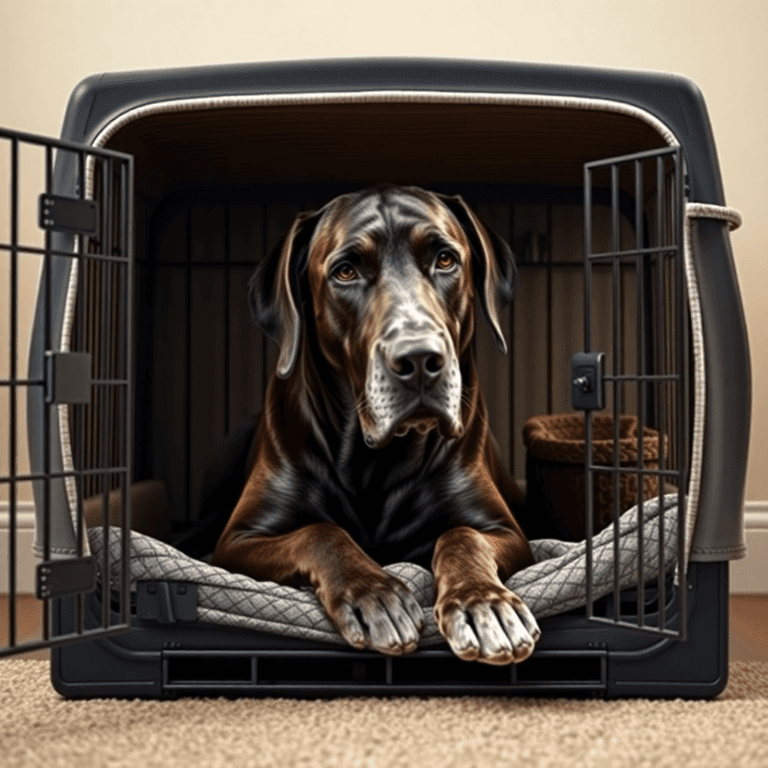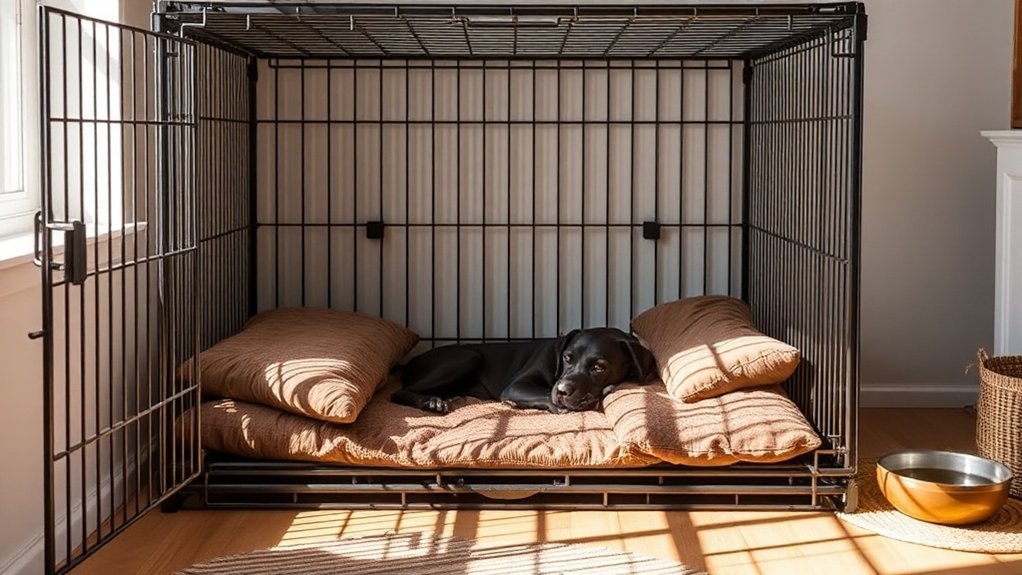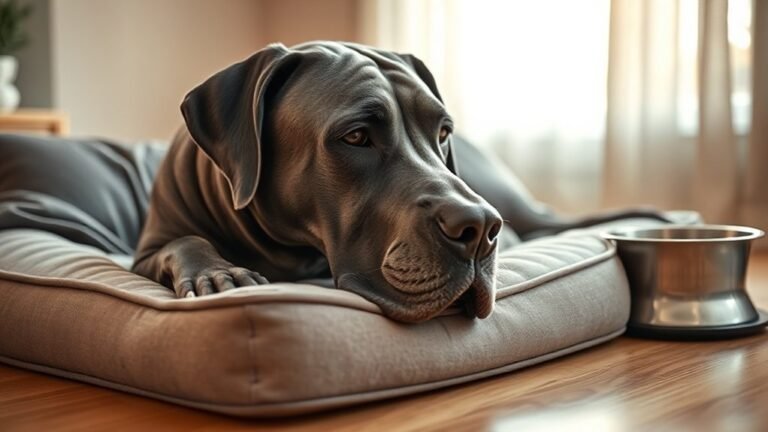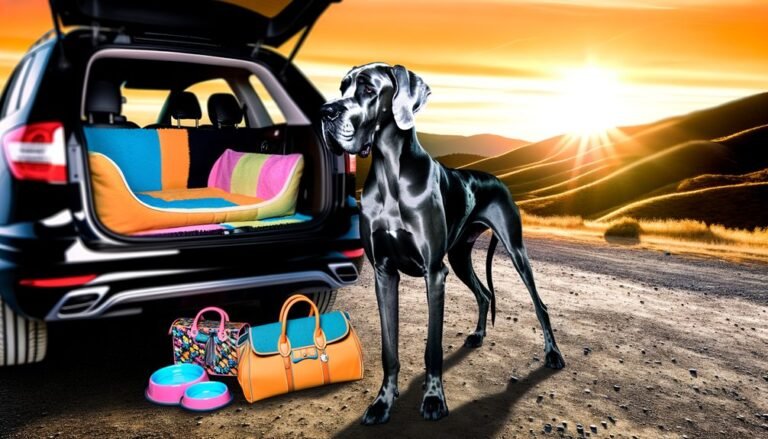Best Crate for a Great Dane

Best Crate for Your Great Dane
Finding the Perfect Crate for Me (A Great Dane‘s Guide)
Let me tell you about finding the right crate for a dog like me. Trust me, I know what works and what doesn’t – I’ve tested plenty of them with my giant paws and even bigger personality!
First things first – size matters when you’re as huge as I am. My humans need to get me a crate that’s at least 36 inches tall. Why? Because I like to stand up and stretch without bonking my head! The length should be between 42 and 48 inches. I need room to sprawl out like the majestic beast I am. If I can’t lie down and stretch my legs without hanging out of the crate, it’s a no-go.
Metal crates are my favorite because they’re super tough. I might be gentle, but I’m also really strong. Plastic crates look nice, but let’s be honest – one enthusiastic tail wag and they might not survive. Metal crates can handle my enthusiasm!
Don’t forget the bedding! My humans better make sure I have something soft to lie on. My joints get tired carrying around all this awesome Great Dane body. A good cushion makes crate time way more enjoyable.
Air flow is really important too. I get hot easily because I’m the size of a miniature horse. Good ventilation keeps me cool and happy. Nobody wants a grumpy Great Dane!
When my humans pick the right crate, it becomes my personal castle. It’s where I can relax, take naps, and watch the world go by. Trust me, get these things right and your Great Dane will love their new space!
Ideal Crate Size for Great Danes
Finding the Perfect Crate Size (From a Great Dane’s Perspective!)
First things first – we need ROOM! I’m talking serious space here, folks. When my humans shop for my crate, they better make sure I can stand up without bonking my massive head on the ceiling. That means at least 36 inches tall, or I’ll be doing this awkward crouch thing that makes my legs cramp.
We need ROOM! A crate should be at least 36 inches tall for comfy standing and no awkward crouching!
Length is super important too. I need at least 42 to 48 inches so I can stretch out my long legs without my paws hanging out like I’m trying to escape. Nothing’s worse than feeling like a pretzel in a tiny box!
Here’s the deal – I should be able to stand up, spin around (which I love doing), and flop down for a good nap without playing Twister. If my crate is too small, I get stressed out and start whining. Nobody wants a cranky Great Dane!
My advice? Measure twice, buy once! Get out that tape measure and check my height and length. A roomy crate makes me a happy dog, and a happy dog makes for happy humans. Proper crate size is essential for comfort and well-being, so don’t cut corners! Win-win!
Crate Material and Durability
When your humans are shopping for our castle, they need to think about what material will survive our… enthusiastic personalities. Here’s the scoop from a dog who’s been there:
- Metal crates: These babies are tough! I’ve tried my best chompers on them, and they don’t budge. Plus, they keep us secure when we get a little too excited about the mailman.
- Wood crates: Sure, they look fancy in your living room, but let me warn you – we Great Danes can turn beautiful wood into expensive toothpicks pretty quickly!
- Insulation: Nobody likes a cold nose in winter! Metal crates can feel like doggy freezers, so look for ones with cozy insulation to keep us warm and happy.
- Ventilation: Make sure air flows through our space. We’re big dogs who need to breathe easy, especially after zoomies around the yard!
Additionally, it’s important to consider our health and wellness when choosing a crate, as a secure and comfortable environment promotes a happy Great Dane.
Comfort and Interior Considerations
Now that my humans figured out what my crate should be made of, let’s talk about the really important stuff – making it super comfy for a giant dog like me!
First up is my bedding. I need something soft and squishy that won’t fall apart when I do my three daily spins before lying down. My humans better pick something they can throw in the washing machine because, let’s be honest, sometimes I come inside with muddy paws or drool a little more than usual.
Soft, squishy bedding is essential for my three spins before settling down—machine washable, of course, because muddy paws happen!
A giant dog needs giant comfort, so thick padding is a must – my bones are big and need cushioning!
Temperature control is huge for us, Great Danes. We’re like walking furnaces, so if you stick my crate next to a heater or in a stuffy corner, I’m going to be one grumpy pup. I need good air flow to keep myself cool. On the flip side, don’t put me in a drafty spot during winter – even though I’m big, I still get chilly! Regular grooming helps remove loose hair, which can help keep my crate cleaner and more comfortable.
When my crate has the perfect bedding and temperature, it becomes my personal palace. I can stretch out, relax, and feel safe. It’s like having my bedroom where I can escape when the world gets too exciting or when I just want to take one of my famous Great Dane naps.
Crate Usage Guidelines and Safety
My humans might think of my crate as a cozy retreat, and honestly, they’re not wrong! But they’d better use it safely if they want me to stay happy.
When my family does crate training right, it’s pretty awesome. Here’s what I need them to remember:
- Pick the right size crate so I can stretch my long legs! I’m not a Chihuahua, people.
- Don’t leave me in there forever – even us Great Danes need bathroom breaks and playtime.
- Make sure I can breathe properly, and please don’t lock me in like I’m some kind of criminal.
- Pay attention if I’m whining or acting weird – I might be trying to tell you something important. Establishing a positive association with my crate is key to my happiness!
Trust me, follow these rules and we’ll both be much happier.
I’ll get my cozy den time, and you won’t have to deal with a grumpy 150-pound dog giving you the stink eye!
Portability and Practicality
Portability and Practicality
Listen up, humans! When choosing a crate for my training, keep in mind how easily it can be moved around. Trust me, I want to come with you everywhere! Choose something lightweight that folds up nicely and easily. My humans are always complaining about their backs, so help them out a little.
Make sure you get me some comfy bedding that travels well, and please use those secure straps! I don’t want to slide around like I’m on a carnival ride. That’s not fun for a big guy like me.
If you’re thinking about taking me places in the car, measure first! I’ve seen my humans try to stuff things in the trunk that clearly don’t fit. Learn from their mistakes.
And if we’re flying somewhere (how exciting!), make sure the airline says it’s okay. I don’t want to get left behind at the airport. Also, keep in mind that the right size pet door is crucial for my comfort and safety during our travels.
When you think about all this stuff ahead of time, I get to travel safely and comfortably wherever we go. Plus, you won’t be stressed out trying to figure everything out at the last minute. It’s a win-win for both of us!
Breed-Specific Needs and Considerations
Hey there, humans! Let me tell you what us Great Danes need to be happy. Trust me, I know what I’m talking about – I’m a miniature horse pretending to be a dog!
First off, we need SPACE. And I mean lots of it. You know how you feel cramped in an airplane seat? That’s me trying to fit in your tiny apartment. We’re not exactly lap dogs (though we’ll try to be one anyway). Give us room to stretch our super-long legs without knocking over your favorite lamp. Again.
We need SPACE, lots of it! Think cramped airplane seat—now imagine me in your tiny apartment!
Next up is sturdiness. Please don’t buy us one of those flimsy dog crates meant for a Chihuahua. We’re not trying to be bulldozers, but when you weigh as much as a small refrigerator, things just… happen. Get us something built like a tank, or you’ll end up with expensive metal confetti all over your floor.
Ventilation is huge for us gentle giants. We get hot fast because we’re furry furnaces. Good airflow keeps us cool and prevents us from turning into panting, drooling messes. Nobody wants that – especially your couch cushions. Additionally, proper nutrition is crucial for our overall well-being, so make sure our diet supports our large size.
Finally, comfort is key. A soft bed and our favorite squeaky toy make all the difference. We might look tough, but we’re just oversized babies who want to feel safe and cozy.
Plus, familiar smells help us relax when we’re feeling nervous about new situations.
Final Thoughts
First off, size matters – and I mean matters. You humans might think that medium crate looks roomy, but have you tried fitting your entire body plus your wagging tail in there? It’s like trying to squeeze into your little cousin’s pajamas. Not happening! We need extra-large crates, or better yet, extra-extra-large ones. My legs are longer than some dogs are tall!
Comfort is super important too. Just because I’m big doesn’t mean I don’t like my beauty sleep. I need enough room to stretch out like the majestic beast I am. And please, PLEASE make sure there’s good padding. My bones are closer to the ground than you think, and concrete-hard floors make for one grumpy Great Dane.
Safety comes first, though. We’re gentle giants, but we’re still giants. Make sure the crate is sturdy enough to withstand my excitement when I see the delivery truck. You don’t want me accidentally turning my crate into modern art!
Don’t wait until I’m already tower-sized to get shopping. Start early, because finding the right crate for us massive pups takes time. Your happy Great Dane equals your happy life – trust me on this one!
References
- https://www.petcratesdirect.com/blogs/news/great-dane-fun-facts-and-crate-size
- https://www.youtube.com/watch?v=ptYRsxzzRdc
- https://www.impactdogcrates.com/blogs/puppy-news/best-dog-crates-for-great-danes
- https://www.dogster.com/lifestyle/what-size-crate-does-a-great-dane-need
- https://www.lovemargot.co/great-dane-blog?p=how-big-should-a-crate-be-for-a-great-dane







2 Comments